
Messier 13 or M13, is a globular cluster of several hundred thousand stars in the constellation of Hercules.

Messier 5 or M5 is a globular cluster in the constellation Serpens. It was discovered by Gottfried Kirch in 1702.

Messier 107 or M107, also known as NGC 6171 or the Crucifix Cluster, is a very loose globular cluster in a very mildly southern part of the sky close to the equator in Ophiuchus, and is the last such object in the Messier Catalogue.

Omega Centauri is a globular cluster in the constellation of Centaurus that was first identified as a non-stellar object by Edmond Halley in 1677. Located at a distance of 17,090 light-years, it is the largest known globular cluster in the Milky Way at a diameter of roughly 150 light-years. It is estimated to contain approximately 10 million stars, with a total mass of 4 million solar masses, making it the most massive known globular cluster in the Milky Way.

Messier 3 is a globular cluster of stars in the northern constellation of Canes Venatici.
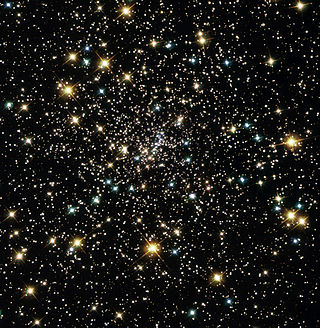
NGC 6397 is a globular cluster in the constellation Ara that was discovered by French astronomer Nicolas-Louis de Lacaille in 1752. It is located about 7,800 light-years from Earth, making it one of the two nearest globular clusters to Earth. The cluster contains around 400,000 stars, and can be seen with the naked eye under good observing conditions.
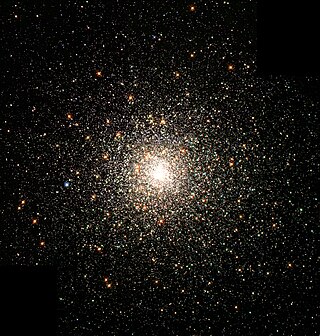
Messier 80 is a globular cluster in the constellation Scorpius. It was discovered by Charles Messier in 1781, being one of his first discoveries.

Messier 10 or M10 is a globular cluster of stars in the equatorial constellation of Ophiuchus. The object was discovered by the French astronomer Charles Messier on May 29, 1764, who cataloged it as number 10 in his catalogue and described it as a "nebula without stars". In 1774, German astronomer Johann Elert Bode likewise called it a "nebulous patch without stars; very pale". Using larger instrumentation, German-born astronomer William Herschel was able to resolve the cluster into its individual members. He described it as a "beautiful cluster of extremely compressed stars". William Parsons, 3rd Earl of Rosse thought he could distinguish a dark lane through part of the cluster. The first to estimate the distance to the cluster was Harlow Shapley, although his derivation of 33,000 light years was much further than the modern value.
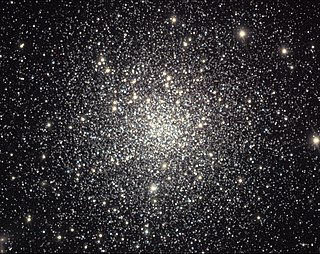
Messier 12 or M 12 is a globular cluster in the constellation of Ophiuchus. It was discovered by the French astronomer Charles Messier on May 30, 1764, who described it as a "nebula without stars". In dark conditions this cluster can be faintly seen with a pair of binoculars. Resolving the stellar components requires a telescope with an aperture of 8 in (20 cm) or greater. In a 10 in (25 cm) scope, the granular core shows a diameter of 3′ (arcminutes) surrounded by a 10′ halo of stars.

Messier 19 or M19 is a globular cluster in the constellation Ophiuchus. It was discovered by Charles Messier on June 5, 1764 and added to his catalogue of comet-like objects that same year. It was resolved into individual stars by William Herschel in 1784. His son, John Herschel, described it as "a superb cluster resolvable into countless stars". The cluster is located 4.5° WSW of Theta Ophiuchi and is just visible as a fuzzy point of light using 50 mm (2.0 in) binoculars. Using a telescope with a 25.4 cm (10.0 in) aperture, the cluster shows an oval appearance with a 3′ × 4′ core and a 5′ × 7′ halo.

Messier 53 is a globular cluster in the Coma Berenices constellation. It was discovered by Johann Elert Bode in 1775. M53 is one of the more outlying globular clusters, being about 60,000 light-years (18.4 kpc) light-years away from the Galactic Center, and almost the same distance from the Solar System. The cluster has a core radius (rc) of 2.18 pc, a half-light radius (rh) of 5.84 pc, and a tidal radius (rtr) of 239.9 pc.
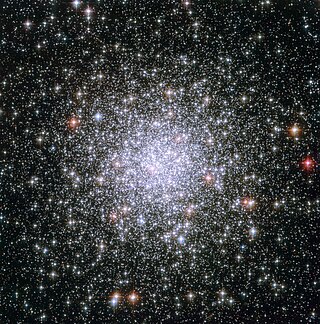
Messier 69 or M69, also known NGC 6637, and NGC 6634, is a globular cluster in the southern constellation of Sagittarius. It can be found 2.5° to the northeast of the star Epsilon Sagittarii and is dimly visible in 50 mm aperture binoculars. The cluster was discovered by Charles Messier on August 31, 1780, the same night he discovered M70. At the time, he was searching for an object described by Nicolas-Louis de Lacaille in 1751–2 and thought he had rediscovered it, but it is unclear if Lacaille actually described M69.

Messier 92 is a globular cluster of stars in the northern constellation of Hercules.

NGC 2419 is a globular cluster in the constellation Lynx. It was discovered by William Herschel on December 31, 1788. NGC 2419 is at a distance of about 300,000 light years from the Solar System and at the same distance from the Galactic Center.

NGC 3201 is a low galactic latitude globular cluster in the southern constellation of Vela. It has a very low central concentration of stars. This cluster was discovered by James Dunlop on May 28, 1826 and listed in his 1827 catalogue. He described it as "a pretty large pretty bright round nebula, 4′ or 5′ diameter, very gradually condensed towards the centre, easily resolved into stars; the figure is rather irregular, and the stars are considerably scattered on the south".

NGC 6752 is a globular cluster in the constellation Pavo. It is the fourth-brightest globular cluster in the sky, after Omega Centauri, 47 Tucanae and Messier 22, respectively. It is best seen from June to October in the Southern Hemisphere. It is also known as NGC 6777, though this identification is uncertain.
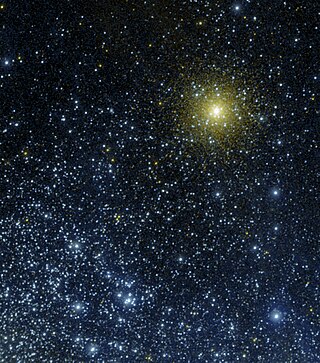
NGC 362 is a globular cluster located in the constellation Tucana in the Southern Hemisphere, slightly north of the Small Magellanic Cloud, to which it is completely unrelated. It was discovered on August 1, 1826, by James Dunlop. It is visible to the naked eye in dark skies, and is an impressive sight in a telescope, although it is somewhat overshadowed by its larger and brighter neighbour 47 Tucanae.
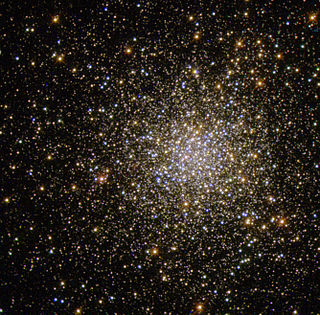
NGC 5694 is a globular cluster in the constellation Hydra. It was discovered in 1784 by William Herschel.
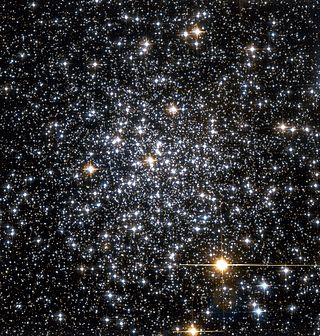
NGC 6352 is a globular cluster of stars in the southern constellation of Ara, located approximately 18.3 kly from the Sun. It was discovered by Scottish astronomer James Dunlop on May 14, 1826. The cluster has a Shapley–Sawyer Concentration Class of XI:. A telescope with a 15 cm (5.9 in) aperture is required to resolve the stars within this loose cluster.
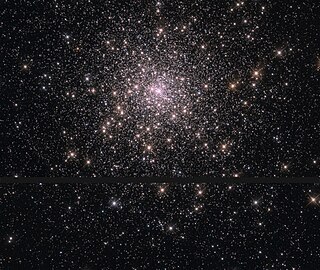
NGC 6284 is a globular cluster located in the constellation Ophiuchus. It is designated as IX in the galaxy morphological classification scheme and was discovered by the German-born British astronomer William Herschel on 22 May 1784. Its distance had previously been estimated at 49,900 light years from Earth, but this was revised in 2023 to around 43,000 light years. This same study, based on high-resolution Hubble Space Telescope optical observations, produced the first high-quality colour-magnitude diagram (CMD) of NGC 6284, extending down to about six magnitudes below its main sequence turn-off. The new observations moved its centre of gravity by 1.5–3 arcseconds from previous values, and its density profile showed a steep central cusp, suggesting that NGC 6284 is a post-core collapse (PCC) cluster.






















